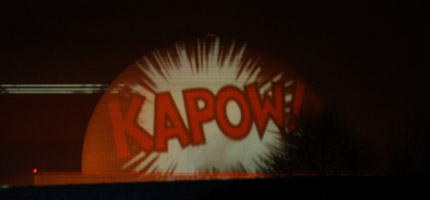
Over the past fortnight an enormous projection reading "KAPOW!" has materialised on several of the UK's nuclear power stations, highlighting the risk of terrorist attack to nuclear sites.
Greenpeace volunteers drove up to the perimeter fences of Dungeness, Sizewell, Wylfa, Oldbury, Heysham and Torness nuclear power stations and projected the cartoon-style image onto the walls.
This exposure of the vulnerability of UK nuclear sites comes at a time when Tony Blair is planning to dramatically increase the risk of a catastrophic terrorist attack by building a new generation of nuclear reactors.
But just how likely is a nuclear terrorist attack?
"Nuclear terrorism is still often treated as science fiction," said UN Secretary General Kofi Annan in 2005. "I wish it were. But unfortunately we live in a world of excess hazardous materials and abundant technological know-how, in which some terrorists clearly state their intention to inflict catastrophic casualties."
There have already been six known direct attacks on nuclear power plants - in France, South Africa, Switzerland, the Philippines and Spain. In fact, The International Policy Institute for Counter Terrorism documents 167 terrorist incidents involving a nuclear target between 1970 and 1999.
According to a taped interview with Al Jazeera, Al Qaeda initially planned to include a nuclear plant in its 2001 attacks. The US Nuclear Regulatory Commission sent a confidential memo to all US nuclear power plants warning of plans for a terrorist attack in which hijackers "fly a commercial aircraft into a nuclear power plant"..
In the UK, detailed plans of Britain's nuclear sites, including Sizewell, were found in a car linked to the July 2005 London bombings.
The results of a terrorist attack on a nuclear power station would be catastrophic; UK nuclear sites aren't built to withstand a deliberate crash by a jumbo jet full of highly explosive aviation fuel. A terrorist strike on Sellafield's storage tanks of radioactive waste has the potential to kill over two million people. A fire in a spent fuel cooling pond at Sizewell B would result in huge releases of radioactivity just 100 miles from London.
"Millions of people could die as a result of a terrorist attack on a nuclear plant," said Sarah North, head of Greenpeace's nuclear campaign. "Yet Tony Blair has put the prospect of building these extremely dangerous facilities back on the agenda, seemingly without a thought for the safety of the public. Nuclear power is simply the wrong answer to climate change."
The UK is failing to reduce our contribution to climate change; CO2 emissions have actually increased in the last two years. The nuclear industry's lobbyists, desperate to revive their dying trade, have seized on this failure and positioned nuclear power as the magic solution to climate change. While all the evidence shows that nuclear power is an immensely wasteful, dirty and expensive option, Tony Blair seems to have fallen for the nuclear PR campaign.
But a solution to climate change does exist. The recently launched WADE report compares an energy system using nuclear power and one using a decentralised system of energy efficiency and renewables, and concludes that not only is the nuclear system dirtier and more dangerous; it also costs over £1bn more.
Find out more
To be truly terrified, download the Greenpeace dossier of expert evidence outlining the vulnerability of the UK's current nuclear sites to terrorist attack (pdf, 53k) or watch your worst nightmare unfold in a short film showing a nuclear terrorism scenario.


